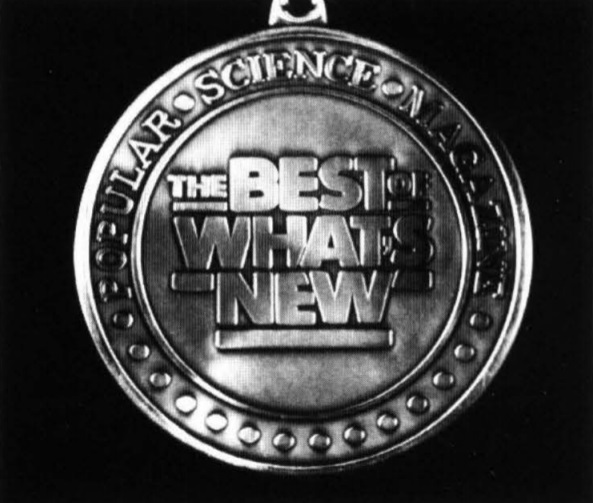"Popular Science" Cites Top Quark Among Year's Outstanding Scientific Achievements

[Best of What's New medal.]
SHOWCASED IN MAGAZINE'S ANNUAL "BEST OF WHAT'S NEW" SECTION
Fermilab's evidence for the top quark has been cited by the editors of Popular Science as one of 1994's innovative achievements in science in the magazine's seventh annual "Best of What's New" special awards section in its December issue.
Fermilab was also featured in the Popular Science 1994 "Best of What's New" Exhibition held November 9 at New York's Tavern on the Green. The exhibition showcased the winning selections. Deputy Director Ken Stanfield and CDF Cospokesperson Bill Carithers represented the Laboratory at the showcase.
The 100 Popular Science winning selections were divided into 10 categories: Audio and Video, Automotive Technology, Aviation, Cars, Computers and Electronics, Environmental Technology, Photography, Recreation, and Science and Technology.
Two teams of experimenters at Fermilab, CDF and DZero, are seeking to study the top quark. Last April, physicists at CDF announced the first direct experimental evidence for top.
Current scientific theory predicts six quarks. Scientists worldwide have sought experimental evidence for the top quark since the discovery of the bottom quark at Fermilab in 1977. The top quark is the most massive of the quarks and the last to be discovered.
A research paper, published in The Physical Review by the 440-member CDF collaboration, presented evidence for the production of top quarks in world-record high-energy collisions between protons and antiprotons at Fermilab's Tevatron particle accelerator. The CDF collaboration also presented its results at a scientific colloquium held April 26 at Fermilab.
The day of CDF's top announcement was the focus of much media attention. Nearly 50 reporters from around the world traveled to Fermilab for a press conference. Reports of the new evidence literally became a story heard around the world. Through newspapers, magazines, various other publications, television programs, radio broadcasts and computer broadcasts, it is estimated that 55 to 60 million people heard the announcement.
Popular Science's December issue, featuring the "Best of What's New," has been the magazine's best-selling issue since the awards were introduced in 1988. Look for the feature on Fermilab in the upcoming issue.


